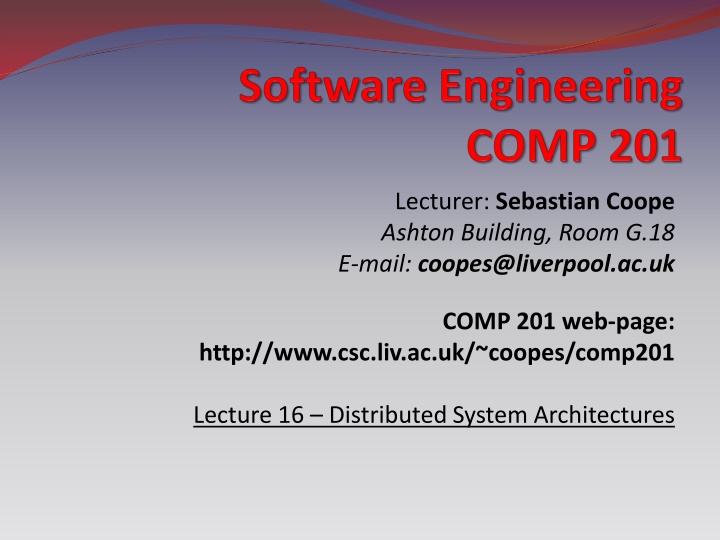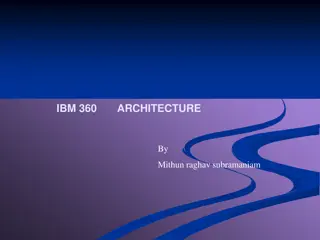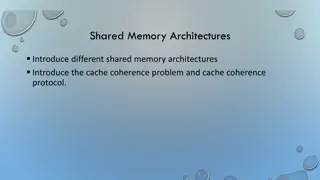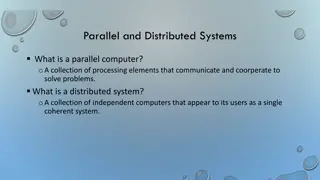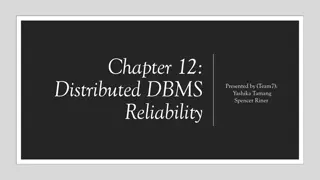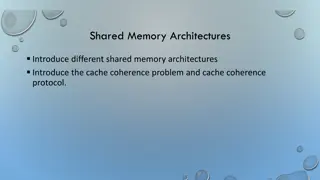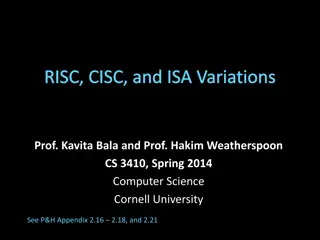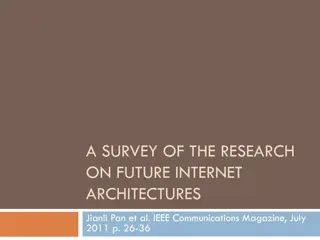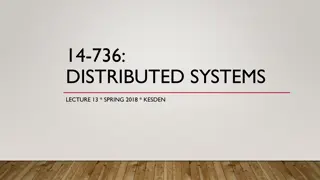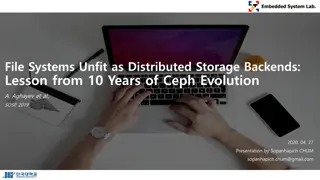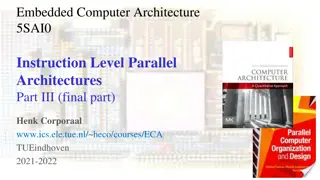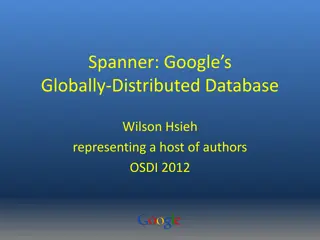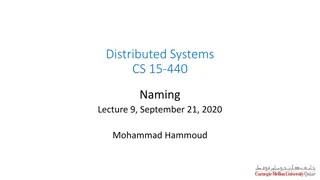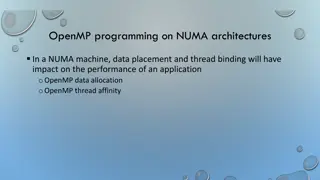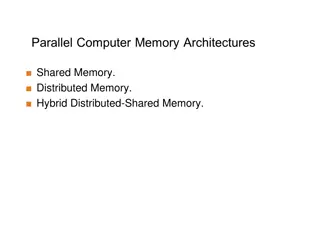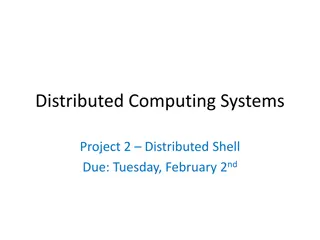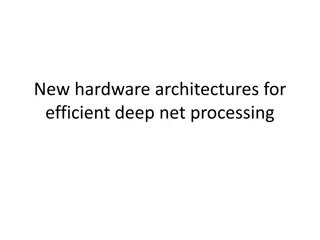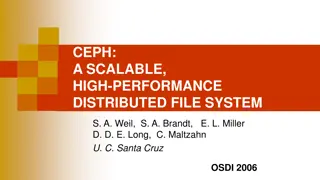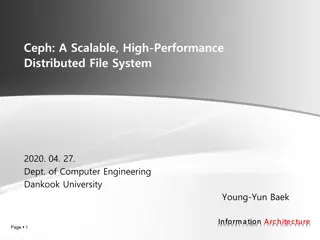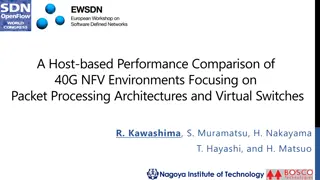Distributed System Architectures Overview
Distributed systems play a crucial role in modern computing, enabling resource sharing, scalability, and fault tolerance. This overview covers architectural designs, system types, characteristics, advantages, and disadvantages of distributed systems, including client-server architectures and middleware.
Download Presentation

Please find below an Image/Link to download the presentation.
The content on the website is provided AS IS for your information and personal use only. It may not be sold, licensed, or shared on other websites without obtaining consent from the author.If you encounter any issues during the download, it is possible that the publisher has removed the file from their server.
You are allowed to download the files provided on this website for personal or commercial use, subject to the condition that they are used lawfully. All files are the property of their respective owners.
The content on the website is provided AS IS for your information and personal use only. It may not be sold, licensed, or shared on other websites without obtaining consent from the author.
E N D
Presentation Transcript
Lecturer: Sebastian Coope Ashton Building, Room G.18 E-mail: coopes@liverpool.ac.uk COMP 201 web-page: http://www.csc.liv.ac.uk/~coopes/comp201 Lecture 16 Distributed System Architectures
Distributed Systems Architectures Architectural design for software that executes on more than one processor COMP201 - Software Engineering 2
Distributed Systems Virtually all large computer-based systems are now distributed systems Information processing is distributed over several computers rather than confined to a single machine Distributed software engineering is now very important COMP201 - Software Engineering 3
System Types Personal systems that are not distributed and that are designed to run on a personal computer or workstation. Embedded systems that run on a single processor or on an integrated group of processors. Distributed systems where the system software runs on a loosely integrated group of cooperating processors linked by a network. COMP201 - Software Engineering 4
Distributed System Characteristics Resource sharing Openness Concurrency Scalability Fault tolerance Transparency Distributed system disadvantages : Complexity Security Manageability Unpredictability COMP201 - Software Engineering 5
Distributed Systems Architectures Client-server architectures Distributed services which are called on by clients. Servers that provide services are treated differently from clients that use services Distributed object architectures No distinction between clients and servers. Any object on the system may provide and use services from other objects COMP201 - Software Engineering 6
Middleware Software that manages and supports the different components of a distributed system. In essence, it sits in the middleof the system Middleware is usually off-the-shelf rather than specially written software Examples Transaction processing monitors Data converters Communication controllers COMP201 - Software Engineering 7
1. Multiprocessor Architectures Simplest distributed system model System composed of multiple processes which may (but need not) execute on different processors Architectural model of many large real-time systems Distribution of process to processor may be pre-ordered or may be under the control of a dispatcher COMP201 - Software Engineering 8
A Multiprocessor Traffic Control System Traffic flow processor Traffic light control processor Sensor processor Light control process Sensor control process Display process Traffic lights Traffic flow sensors and cameras Operator consoles COMP201 - Software Engineering 9
2. Client-Server Architectures The application is modelled as a set of services that are provided by servers and a set of clients that use these services Clients know of servers but servers need not know of clients Clients and servers are logical processes The mapping of processors to processes is not necessarily 1 : 1 COMP201 - Software Engineering 10
A Client-Server System c3 c2 c4 c12 c11 Server process c1 s1 s4 c10 c5 Client process s2 s3 c9 c6 c8 c7 COMP201 - Software Engineering 11
Computers in a C/S Network c1 c2 c3, c4 CC1 CC2 CC3 Network Server computer s3, s4 s1, s2 SC1 SC2 Client computer c5, c6, c7 c8, c9 c10, c11, c12 CC4 CC5 CC6 COMP201 - Software Engineering 12
Layered Application Architecture Presentation layer Concerned with presenting the results of a computation to system users and with collecting user inputs Application processing layer Concerned with providing application specific functionality e.g., in a banking system, banking functions such as open account, close account, etc. Data management layer Concerned with managing the system databases COMP201 - Software Engineering 13
Application Layers Presentation layer Application processing layer Data management layer COMP201 - Software Engineering 14
Thin and Fat Clients Thin-client model In a thin-client model, all of the application processing and data management is carried out on the server. The client is simply responsible for running the presentation software. Fat-client model In this model, the server is only responsible for data management. Thesoftware on the client implements the application logic and the interactions with the system user. COMP201 - Software Engineering 15
Thin and Fat Clients Presentation Server Thin-client model Data management Application processing Client Presentation Application processing Server Fat-client model Client Data management COMP201 - Software Engineering 16
Thin Client Model Used when legacy systems are migrated to client server architectures. The legacy system acts as a server in its own right with a graphical interface implemented on a client A major disadvantage is that it places a heavy processing load on both the server and the network COMP201 - Software Engineering 17
Fat Client Model More processing is delegated to the client as the application processing is locally executed Most suitable for new client-server systems where the capabilities of the client system are known in advance More complex than a thin client model especially for management. New versions of the application have to be installed on all clients COMP201 - Software Engineering 18
A Client-Server ATM System ATM ATM Account server Tele- Customer account database processing monitor ATM ATM COMP201 - Software Engineering 19
Three-Tier Architectures In a three-tier architecture, each of the application architecture layers may execute on a separate processor Allows for better performance than a thin-client approach and is simpler to manage than a fat-client approach A more scalable architecture - as demands increase, extra servers can be added to the data management or application processing layers. COMP201 - Software Engineering 20
A 3-Tier Client-Server Architecture Presentation Server Server Client Data Application processing management COMP201 - Software Engineering 21
An Internet Banking System Client HTTP interaction Database server Web server SQL query Customer account database Client Account service provision SQL Client Client COMP201 - Software Engineering 22
Use of Client-Server Architectures Architecture Applications Two-tier C/S with thin clients Legacy system applications where separating application processing and data management is impractical. Computationally-intensive applications such as compilers with little or no data management. Data-intensive applications (browsing/querying) with little or no application processing. Two-tier C/S with fat clients Applications where processing uses off-the-shelf software (eg. Microsoft Excel) on the client. Applications with relatively stable end-user functionality used in an environment with well-established system management. Three-tier or multi-tier C/S architecture Large-scale applications with hundreds or thousands of clients. Applications where both the data and applications are volatile. COMP201 - Software Engineering 23
3. Distributed Object Architectures There is no distinction in a distributed object architectures between clients and servers Each distributable entity is an object that provides services to other objects and receives services from other objects Object communication is through a middleware system called an object request broker (software bus) However, they can be more complex to design than client- server systems COMP201 - Software Engineering 24
Distributed Object Architecture o1 o2 o3 o4 S (o1) S (o2) S (o3) S (o4) Software bus o5 o6 S (o6) S (o5) COMP201 - Software Engineering 25
Advantages of Distributed Object Architecture It allows the system designer to delay decisions on where and how services should be provided Service-providing objects can execute on any node of the network and thus the distinction between thin/fat-client models becomes irrelevant. It is a very open system architecture that allows new resources to be added to it as required Object communication standards have been developed allowing objects written in different languages to communicate with each other. COMP201 - Software Engineering 26
Advantages of Distributed Object Architecture The system is flexible and scalable New objects can be added as the load on the system increases without disrupting the other system objects. Replicated object can be created to cope with load. It is possible to reconfigure the system dynamically with objects migrating across the network as required This may be important when there is fluctuating patterns of demand on services. A service-providing object can migrate to the same processor as service-requesting objects, thus improving performance. COMP201 - Software Engineering 27
Lecture Key Points Client-server systems are distributed systems where the system is modelled as a set of services provided by servers to client processes. In a client-server system, the user interface always runs on a client and data management is always provided by a shared server. Application functionality may be implemented on the client computer or the server. COMP201 - Software Engineering 28
Lecture Key Points In a distributed object architecture, there is no distinction between clients and servers; objects provide general services that may be called on by other objects. Distributed object systems require middleware to handle object communications and to allow objects to be added or removed from the system. COMP201 - Software Engineering 29
